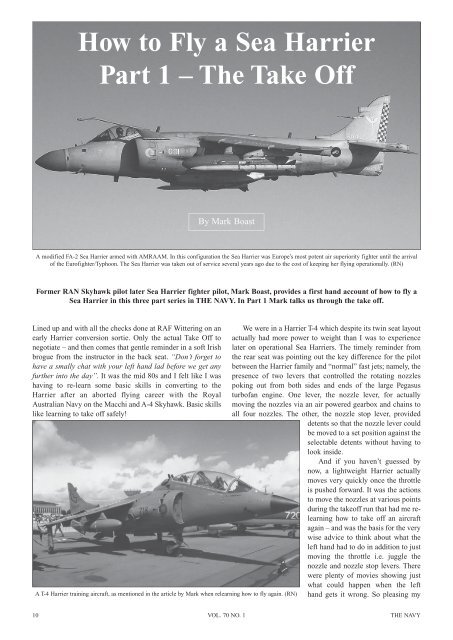The Navy Vol_70_No_1 Jan 2008 - Navy League of Australia
The Navy Vol_70_No_1 Jan 2008 - Navy League of Australia
The Navy Vol_70_No_1 Jan 2008 - Navy League of Australia
- No tags were found...
You also want an ePaper? Increase the reach of your titles
YUMPU automatically turns print PDFs into web optimized ePapers that Google loves.
How to Fly a Sea HarrierPart 1 – <strong>The</strong> Take OffBy Mark BoastA modified FA-2 Sea Harrier armed with AMRAAM. In this configuration the Sea Harrier was Europe’s most potent air superiority fighter until the arrival<strong>of</strong> the Eur<strong>of</strong>ighter/Typhoon. <strong>The</strong> Sea Harrier was taken out <strong>of</strong> service several years ago due to the cost <strong>of</strong> keeping her flying operationally. (RN)Former RAN Skyhawk pilot later Sea Harrier fighter pilot, Mark Boast, provides a first hand account <strong>of</strong> how to fly aSea Harrier in this three part series in THE NAVY. In Part 1 Mark talks us through the take <strong>of</strong>f.Lined up and with all the checks done at RAF Wittering on anearly Harrier conversion sortie. Only the actual Take Off tonegotiate – and then comes that gentle reminder in a s<strong>of</strong>t Irishbrogue from the instructor in the back seat. “Don’t forget tohave a smally chat with your left hand lad before we get anyfurther into the day”. It was the mid 80s and I felt like I washaving to re-learn some basic skills in converting to theHarrier after an aborted flying career with the Royal<strong>Australia</strong>n <strong>Navy</strong> on the Macchi and A-4 Skyhawk. Basic skillslike learning to take <strong>of</strong>f safely!A T-4 Harrier training aircraft, as mentioned in the article by Mark when relearning how to fly again. (RN)We were in a Harrier T-4 which despite its twin seat layoutactually had more power to weight than I was to experiencelater on operational Sea Harriers. <strong>The</strong> timely reminder fromthe rear seat was pointing out the key difference for the pilotbetween the Harrier family and “normal” fast jets; namely, thepresence <strong>of</strong> two levers that controlled the rotating nozzlespoking out from both sides and ends <strong>of</strong> the large Pegasusturb<strong>of</strong>an engine. One lever, the nozzle lever, for actuallymoving the nozzles via an air powered gearbox and chains toall four nozzles. <strong>The</strong> other, the nozzle stop lever, provideddetents so that the nozzle lever couldbe moved to a set position against theselectable detents without having tolook inside.And if you haven’t guessed bynow, a lightweight Harrier actuallymoves very quickly once the throttleis pushed forward. It was the actionsto move the nozzles at various pointsduring the take<strong>of</strong>f run that had me relearninghow to take <strong>of</strong>f an aircraftagain – and was the basis for the verywise advice to think about what theleft hand had to do in addition to justmoving the throttle i.e. juggle thenozzle and nozzle stop levers. <strong>The</strong>rewere plenty <strong>of</strong> movies showing justwhat could happen when the lefthand gets it wrong. So pleasing my10 VOL. <strong>70</strong> NO. 1 THE NAVY
















